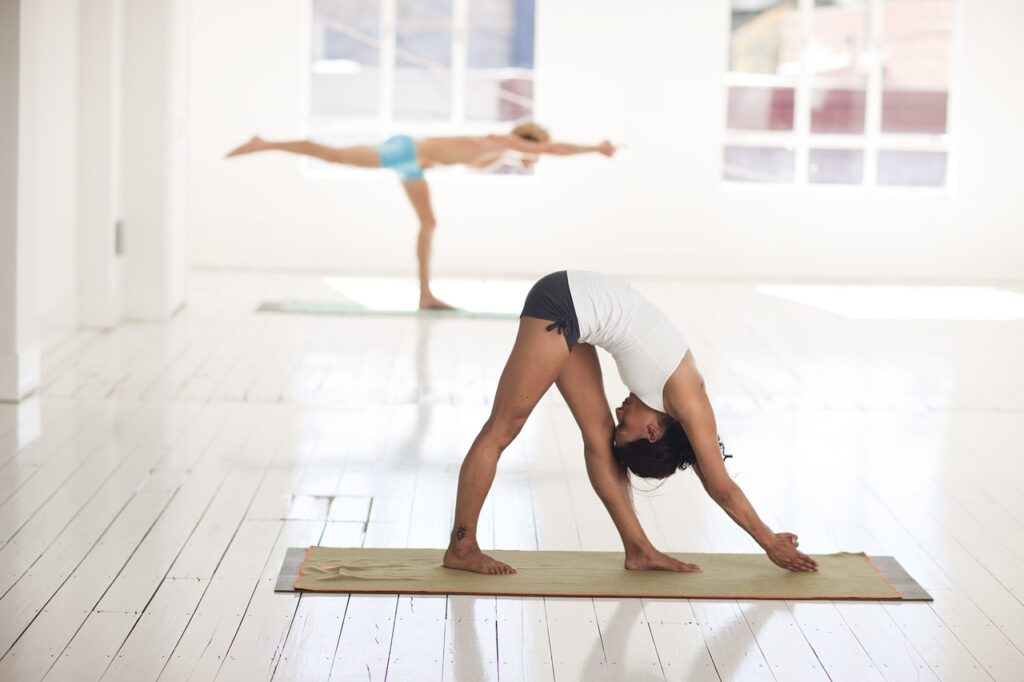Are you sick and weary of exercises that don’t provide any kind of challenge? Stop searching; power yoga is the answer. This vigorous style of yoga not only strengthens the body but also soothes the mind and reduces anxiety. In this post, we’ll discuss the merits of power yoga, how to get started with it, and how to make it part of your regular exercise regimen.

Introduction
The practice of “power yoga” first emerged in the 1990s in the United States. It is a rigorous physical practice that incorporates classic yoga postures with dynamic movements. Power yoga, as opposed to other styles of yoga, is designed to increase muscular strength, stamina, and flexibility. It may also help you relax, lessen tension, and gain perspective.
Power Yoga Asanas and Their Varieties
It includes many different positions that may be adjusted to meet the needs of practitioners of varying fitness and experience levels. Power yoga often consists of the following sorts of postures:
1.Standing Poses
This yoga relies mostly on standing postures, which strengthen the legs, core, and upper body. Examples of typical standing yoga positions include:

- Warrior It is a great position for building leg and hip strength, stabilizing the core, and sharpening concentration.
- Warrior II is a great hip, thigh, and chest opener that also benefits your posture and breathing.
- In addition to enhancing leg and core strength, tree pose also helps with balance and concentration.
2.Balancing Poses
Power yoga’s balancing positions test the practitioner’s mental and physical fortitude. Your posture, equilibrium, and concentration will all benefit from using them. Power yoga often includes balancing positions such as:

- Balance, core strength, and mobility may all benefit from holding a half-moon stance.
- The benefits of crow pose include increased strength in the arms, wrists, and core, as well as enhanced stability and mental clarity.
- Posing in a handstand involves a lot of upper-body power and balance, but the benefits are worth the effort.
3.Inverted Asanas
Many practitioners of power yoga swear by the health advantages of inversion postures, which entail flipping the body upside down. They have been shown to boost blood flow, decrease tension, and sharpen mental focus. Some typical examples of inverted postures are:

- The benefits of the headstand include increased stability, strength, and focus.
- Shoulder stand is a relaxing and calming yoga position that aids in digestion and stress relief.
4.Plow Pose: This position may assist in increasing blood flow while also stretching your back, neck, and shoulders.

5.Seated Poses
Power yoga’s seated postures are excellent for stress reduction, core strength, and flexibility. Your breathing and posture will both benefit from their use. Here are some typical SAT positions:

- The abdomen, back, and hip flexors are all worked on in Boat Pose, which also helps with balance and concentration.
- The hamstrings, calves, and hips get a good stretch in the forward fold, and it also helps relax the mind and relieve tension.
- Lotus Pose is a great hip-opener that also benefits your spine and lungs.
Power Yoga’s Many Rewards
It’s good for you in many ways, both physically and mentally. Some of the primary advantages of power yoga are as follows:
- Strength and stamina are both boosted by this exercise, making it a great choice for anyone trying to get in shape.
- Stretching stretches included throughout the practice may aid in increasing mobility and adaptability.
- Calms the mind and body: As an added bonus, this activity is great for reducing stress.
Helpful Hints for Novices
Here are some pointers for novice power yoga practitioners:
- Don’t overdo it at first; ease into it. Classes should begin at a starting level and progress to more advanced levels.
- Pay attention to your body. If a posture is uncomfortable, make adjustments or go on to another. It’s essential to pay attention to your body and refrain from overextending yourself.
- Drink plenty of water before, during, and after class since it is generally done in a hot setting.
- Put on comfortable clothes. You’ll be on the move quite a bit, so you should dress in loose, breathable fabrics that will help keep you dry and cool.
- You will probably perspire heavily throughout class; therefore, it’s a good idea to bring a towel to wipe away perspiration and prevent your mat from slipping.
Methods for Including Power Yoga in Your Exercise Schedule
- You can do it on its own or add it to your regular workout. Some strength yoga exercises include the following:
- You may do it instead of jogging or cycling since it’s an excellent cardio exercise.
- Incorporate some power yoga postures into your warm-up practice to prepare your body for more strenuous activity.
- Low-impact exercises like these are ideal for rest days since they help with flexibility and tension.
- When coupled with weight training, it greatly enhances the benefits of flexibility and balance.
- Get in on a Challenge! A lot of yoga centers have power yoga challenges where you sign up to do a specific number of courses in a given amount of time. The ability to look back and recognize how far one has come may be a powerful motivator.
